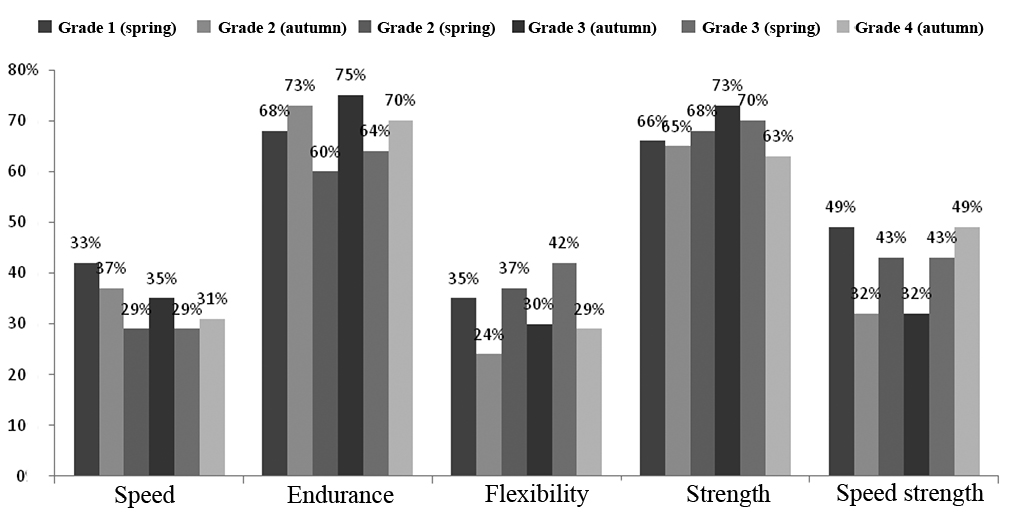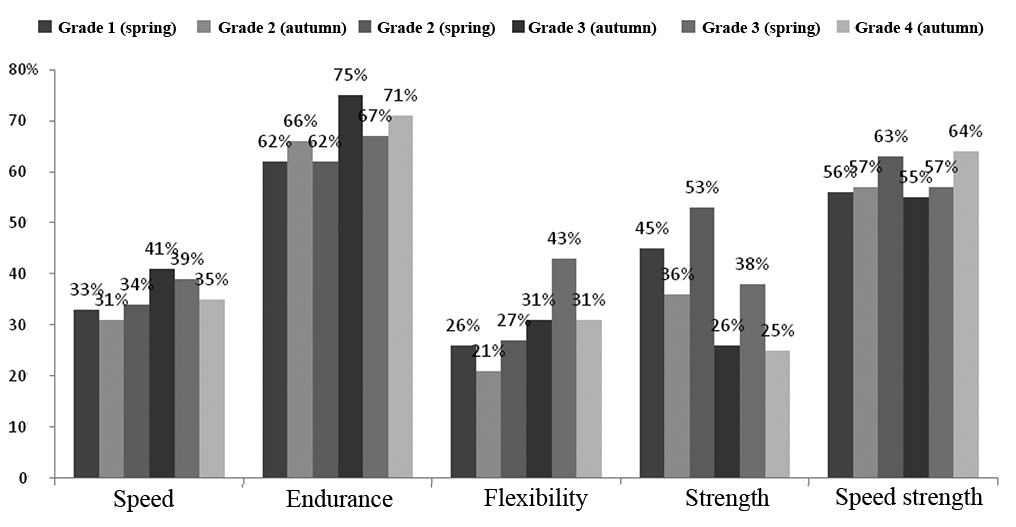Effects of summer vacations on primary pupils' physical fitness test rates
Фотографии:
ˑ:
Dr.Hab., Professor, Honoured Worker of Physical Culture L.A. Semenov1
PhD, Associate Professor V.V. Vlasov1
1Surgut State Pedagogical University, Surgut
Keywords: overall physical fitness, physical qualities, primary school children, summer vacations, GTO complex.
Background. In one of our recent publications, we considered the sagging trend in the overall physical fitness rates of the general education school children in the post-vacation time [6]. We believe that in the context of this general regress in the school children’s physical fitness rates (leaving aside the age-specific variations), a special priority needs to be given to the primary school children’s physical fitness rating studies. It is a common knowledge that this age group is most sensitive to stimulating effects of physical practices geared to develop physical qualities by the age-specific natural biological processes being activated in the growing body [1, 2 et al].
The study is further necessitated by the ongoing reinstatement of the Physical Education and Sports GTO Complex with two classes of its tests designed for the primary school age and dominated by the standard physical qualities rating tests. It might well be that the summer vacation time offers an excellent opportunity for the children’s training for the GTO Complex tests.
Objective of the study was to analyse the effects of summer vacations on the primary school population physical fitness test rates.
Methods and structure of the study. The study was performed in May 2012 (at the school year end) and in September-October 2012 (after the summer vacations and at the beginning of the school year) at 14 general education schools in one of the municipal districts of the Sverdlovsk region, with 2,240 primary (1-4-grade) pupils being subject to the study. The subjects’ physical fitness was rated by the standard set of tests recommended by the Russian monitoring service in application to this school age group including: 30m sprint (speed) test; 1000m race (endurance) tests; standing long jump (speed-strength) test; 30-second crunches (girls’ strength) test; pull-ups on a high bar (boys’ strength) test; plus straight leg stretch exercise (flexibility) test.
The above test methods are largely the same as in the most popular Russian physical education program developed under leadership of V.I. Lyakh [4] and including the relevant test standards. The test standard for the 6 minute run test of the latter program was replaced by the 1000m run test standard, both of the standards being harmonised. Furthermore, we applied two rating scales currently widely applied within the national physical education system, namely the ratio scale and nominal scale [3, 5 et al]. The ratio scale is applied to compare the subjects’ test rates (prior to and after the summer vacations) with the test standards. And the nominal scale nominates the lagging behind (in percentage terms) share of the subjects showing the below-average test rates in every physical quality rating test. These low test rates were subject to a special analysis under the study.
Study results and discussion. Shares of the primary school population tested with the low physical quality rates prior to and after the summer vacations are given on Figure 1 (boys) and Figure 2 (girls) hereunder.

Figure 1. Variations in the shares of the male primary school population tested with low physical quality rates prior to and after the summer vacations.
Grade 1 (spring) Grade 2 (autumn) Grade 2 (spring) Grade 3 (autumn) Grade 3 (spring) Grade 4 (autumn)
Speed Endurance Flexibility Strength Speed strength

Figure 2. Variations in the shares of the female primary school population tested with low physical quality rates prior to and after the summer vacations.
Grade 1 (spring) Grade 2 (autumn) Grade 2 (spring) Grade 3 (autumn) Grade 3 (spring) Grade 4 (autumn)
Speed Endurance Flexibility Strength Speed strength
What should be noted first in the above data – if we leave for a while the seasonal variations – we can see the particularly large share of the low endurance rates in both gender groups; low strength rates in the male group; and the low speed strength rates in the female group. We should also underline the stalled progress for the four school years in the endurance rates in the male and female groups; speed and speed strength rates in the female group; strength rates in the male group; and the flexibility rates in both gender groups.
Now if we come straight to the subject matter of the study, the above data may be interpreted as indicative of the certain developmental specifics of the primary school population rated low on the physical fitness scale prior to and after the summer vacations – versus the age-unspecific consolidated test rates of the general school population [6]. It should be noted that the age-unspecific consolidated test rates of the general school population show a clear regress in every tested physical quality – albeit the situation is somewhat different for the primary school age. Some of the post-vacation physical qualities in this age group show improvements of the test rates (i.e. reduction of low-rated subjects’ share), with the trend being particularly expressed in the boy’s flexibility rates (Figure 2) and the girls’ strength rates (Figure 2). In these two test domains, we see a clear progress in both of the primary school groups.
Furthermore, some school grade(s) may show a progress in some physical quality rates associated with a regress in the other quality rates. Thus in the speed test rates the low-rated male primary school children’s share tends to fall after the first grade followed by some growth after the second and third grade; and the low-rated female primary population share tends to drop after the first and third grade and increase after the second grade. In the flexibility test rates, the low-rated post-vacation primary female population share tends to drop after the first and third grade and somewhat grow after the second grade. In the speed strength domain, the girls show progress after the second grade versus some regress after the first and third grade. Virtually the same variations may be found in the strength and speed strength test rates of the male primary school children: see Figure 1.
Such “mitigation” of the general sagging trend in the post-vacation physical fitness (as verified by the physical quality test rates) may be due to the intensive spontaneous physical activity during summer vacations natural for this age group – as opposed to more senior school ages. It should be mentioned, however, that the sag mitigation trend does not apply in fact to the post-vacation endurance rates in both primary gender groups – since the low-endurance-rated shares in both of the gender groups only grow after the summer vacations. The most serious regress in the endurance test rates was found in the third grade entrants, with the low- endurance-rated boys’ and girls’ shares tested to grow by 15% and 13%, respectively. This regress is particularly unusual in the context of the biomedical study data showing the post-vacation growth of haemoglobin and erythrocyte levels in this age group versus the relevant spring time data [7].
Conclusion. The study data and analyses showed some “mitigation” of the general sagging trend in the post-vacation physical fitness rates of the primary school population, as verified by the physical quality test rates (particularly the speed and speed strength rates in both genders and flexibility in the female group), plus an expressed progress in the flexibility test rates in the male group and the strength rates in the female group. We assume these trends may be due to the natural age-specific intensive physical activity in the summer vacation time. The physical fitness progress/ regress data and variations profiled by the study demonstrate the need for focused efforts to improve the primary school children’s physical fitness rates during summer vacations.
A special emphasis in the above efforts needs to be made on the endurance building practices since this physical quality always sags after summer vacations in all school age groups on the whole and the primary school group in particular. It is also important to remind in this context that the endurance building exercises are known to be of particularly positive influence on the biological processes of the growing body in this age category.
The focused physical quality building practices of the primary school population timed to summer vacations may be highly beneficial for the children’s training for the age-specific GTO Complex tests. Such initiatives may be implemented in the children’s health (countryside, daily etc.) camps and in their families, conditional on the families being duly informed, trained and motivated for such trainings.
References
- Bal'sevich V.K. Ontokineziologiya cheloveka [Human Ontokinesiology]. Moscow: Teoriya i praktika fiz. kultury i sporta publ., 2000, 275 p.
- Gandelsman A.B., Smirnov K.M. Fizicheskoe vospitanie detey shkolnogo vozrasta (mediko-biologicheskie osnovy [Physical education of school-age children (biomedical basics)]. Moscow: Fizkultura i sport publ., 1966, 256 p.
- Zheleznyak Y.D., Petrov P.K. Osnovy nauchno-metodicheskoy deyatelnosti v fizicheskoy kulture i sporte [Fundamentals of scientific and methodological activities in physical culture and sports]. Moscow: Akademiya publ., 2002, 264 p.
- Lyakh V.I., Zdanevich A.A. Kompleksnaya programma fizicheskogo vospitaniya uchashchikhsya I-XI klassov obscheobrazovatelnoy shkoly: programmy obscheobrazovatelnykh uchrezhdeniy [Comprehensive program of physical education of I-XI graders of general education school: general education institutions' curricula]. Moscow: Prosveschenie publ., 2011b 128 pp.
- Semenov L.A. Vvedenie v nauchno-issledovatelskuyu deyatelnost v sfere fizicheskoy kultury i sporta [Introduction into research and development in the field of physical culture and sports] Moscow: Sovetskiy sport publ., 2011, 200 p.
- Semenov L.A. Obshchie tendentsii izmeneniya sostoyaniya konditsionnoy fizicheskoy podgotovlennosti uchashchikhsya obshcheobrazovatelnykh shkol do i posle letnikh kanikul [General trends of changes in state of overall physical fitness of general education school pupils before and after summer vacations]. Uchenye zapiski un-ta im. P.F. Lesgafta, 2017, no. 2(144), pp. 229-234.
- Serdyukovskaya N.G. Moscow: Meditsina publ., 1979, 184 p.
Corresponding author: physical_science@surgpu.ru
Abstract
The study analyses the effects of summer vacations on the primary school children’s physical fitness test rates.
The study was performed at 14 general education schools in Sverdlovsk region, with 2,240 primary (1-4-grade) school children being subject to the study. The subjects’ physical fitness was rated by the standard set of tests recommended by the Russian monitoring service in application to this age group including: 30m sprint (speed) test; 1000m race (endurance) tests; standing long jump (speed-strength) test; 30-second crunches (girls’ strength) test; pull-ups on a high bar (boys’ strength) test; plus straight leg stretch exercise (flexibility) test.
The study data and analyses showed that, notwithstanding the natural growth of the children’s motor activity in summer time, variations in their physical fitness rates at the beginning of the school year are little if any in fact. It should be noted that the endurance rates tend to fall in this age group.
The authors made the conclusion that the children’s physical qualities need to be purposefully developed during summer vacations to ensure physical health progress in this age group and to make the children more fit for the Russian Physical Culture and Sports GTO Complex tests.



